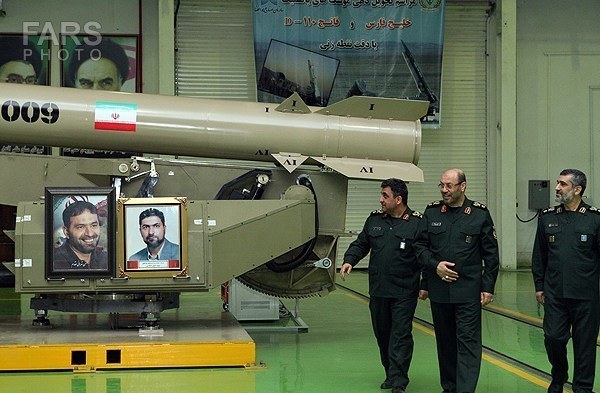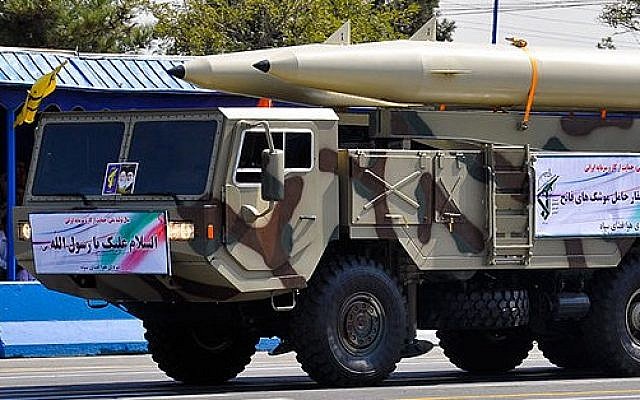When it comes to ballistic missiles these guys aint joking. In a shot span Iran has amassed the largest ballistic missile fleet in the Middle East.
Deterring regional adversaries from threatening Iran is the primary reason Tehran has amassed the largest ballistic missile force in the Middle East.
The missile program actually began under the Shah, but it was accelerated during the Iran-Iraq War in order to threaten Saddam Hussein with strikes deep in Iraqi territory. Since then, Iran has worked with countries like Libya, North Korea and China in order to develop a large and diverse arsenal of ballistic and cruise missiles that form one part of its three-leg deterrent strategy. With Iran now using missiles in conflict, it’s worth taking a closer look at the weapons in its arsenal.
Shahab-Series
The backbone of Iran’s missile forces are the Shahab-series of liquid-fueled (mostly) short-range ballistic missiles (SRBM). There are three variants of the missile: The Shahab-1, Shahab-2 and Shahab-3. The Shahab-1 was the first missile Iran acquired and is based on the Soviet Scud-B missile.
The Shab-1 has a reported range between 285–330 kilometers, and can carry a warhead of around one thousand kilograms. Iran is believed to have three hundred Shahab-1 rockets. Later Iran acquired Shahab-2 missiles, likely from North Korea.


This missile has a range of five hundred kilometers with a payload capacity of 770 kilograms.
Most importantly is the Shahab-3, also a liquid-fueled, road-mobile missile. The Shahab-3 is the first medium-range ballistic missile Iran acquired, with a likely range of between 1,000-1,300 kilometers depending on the size of the payload. The payloads themselves are said to weigh between between 760 and 1,200 kilograms. The Shahab-3 is widely believed to be based on North Korea’s No Dong-1 missile, which itself likely relied heavily on Soviet technology.

Unlike the other Shahab-variants, the Shahab-3 is a two-stage missile with an engine and separate reentry vehicle.
It is unknown how many Shahab-3 missiles Iran has deployed, in part because Tehran appears to rely mostly on a number of variants of the missile, which go by a number of different names like the Emad and Ghadr. These later editions of the missile incorporate Pakistani technology, have a redesigned reentry vehicle, and improved navigation and guidance systems. It’s possible, but unlikely, that some of these variants use solid fuel. They do have an improved range of somewhere between 1,500–1,800 kilometers, and perhaps as high as 2,500 kilometers.
Fateh-Series
The Fateh-series missiles are the solid-fueled counterparts of Shahab missiles. Like the Shahab-1 and Shahab-2, the Fateh-110 and Faeth-331 are short-range and road-mobile. The Fateh-110 is a single-stage missile with a range of 210 kilometers.


Iran began developing the Fateh-110 in 1995, with the first test coming in May 2001. The missile became operational in 2004. The Fateh-313 extends the range of the Fateh-110 to roughly five hundred kilometers, and also has other upgrades such as greater accuracy.
Last year, Iran unveiled a new part of the Fateh family, called the Zolfaghar. When Iran first revealed the missile, Defense Minister Hossein Dehghan claimed it had a range of seven hundred kilometers
Fars News Agency, which is close to the IRGC, reported that the Zolfaghar “is capable of carrying Multiple Reentry Vehicle (MRV) payloads,” although this seems unlikely.
Sejjil
The Sejjil medium-range ballistic missile is the solid-fueled counterpart to the Shahab-3 liquid-fueled missile discussed above. The Sejjil missile has a similar size, weight and range to the Shahab-3. Specifically, the two-stage missile has a range of two thousand kilometers and can carry a warhead of between 500–1500 kilograms.
Iran has claimed that it has developed multiple variants of the missile, including a Sejjil-3 missile that some analysts believe will have a maximum range of four thousand kilometers.
Khalij Fars
Last but not least, Iran has developed an anti-ship ballistic missile to enhance its anti-access/area denial strategy against the U.S. military in the Persian Gulf. Appropriately enough, Iran named this missile Khalij Fars (Persian Gulf).

Based off of the Fateh-110, the Khalij Fars was first tested in early 2011, and coincided with Iran announcing the completion of a long-range, passive radar covering a 1,100 kilometer-radius.
Later that year Iran announced that the missile had entered mass production. In tests since that time Iran has claimed, rather implausibly, the missile registered a 100 percent success rate in hitting ship-like platforms positioned in the Persian Gulf.
According to Iranian media outlets, “the supersonic projectile, which carries a 650-kilogram warhead, is immune to interception and features high-precision systems.” An Iranian general has bragged in 2013, “Today, Iran has missiles that can crush U.S. warships like a can and send them deep into water.” Iran has also unveiled two variants of the Khalij Fars: the passive radar-guided Hormuz-1 and the active radar-guided Hormuz-2.
Conclusion
Ballistic missiles are also the most blunt prong of Iran’s deterrent strategy, which also includes the use of proxies and asymmetric naval warfare, but they are no match to what the U.S brings to the table in the region.

